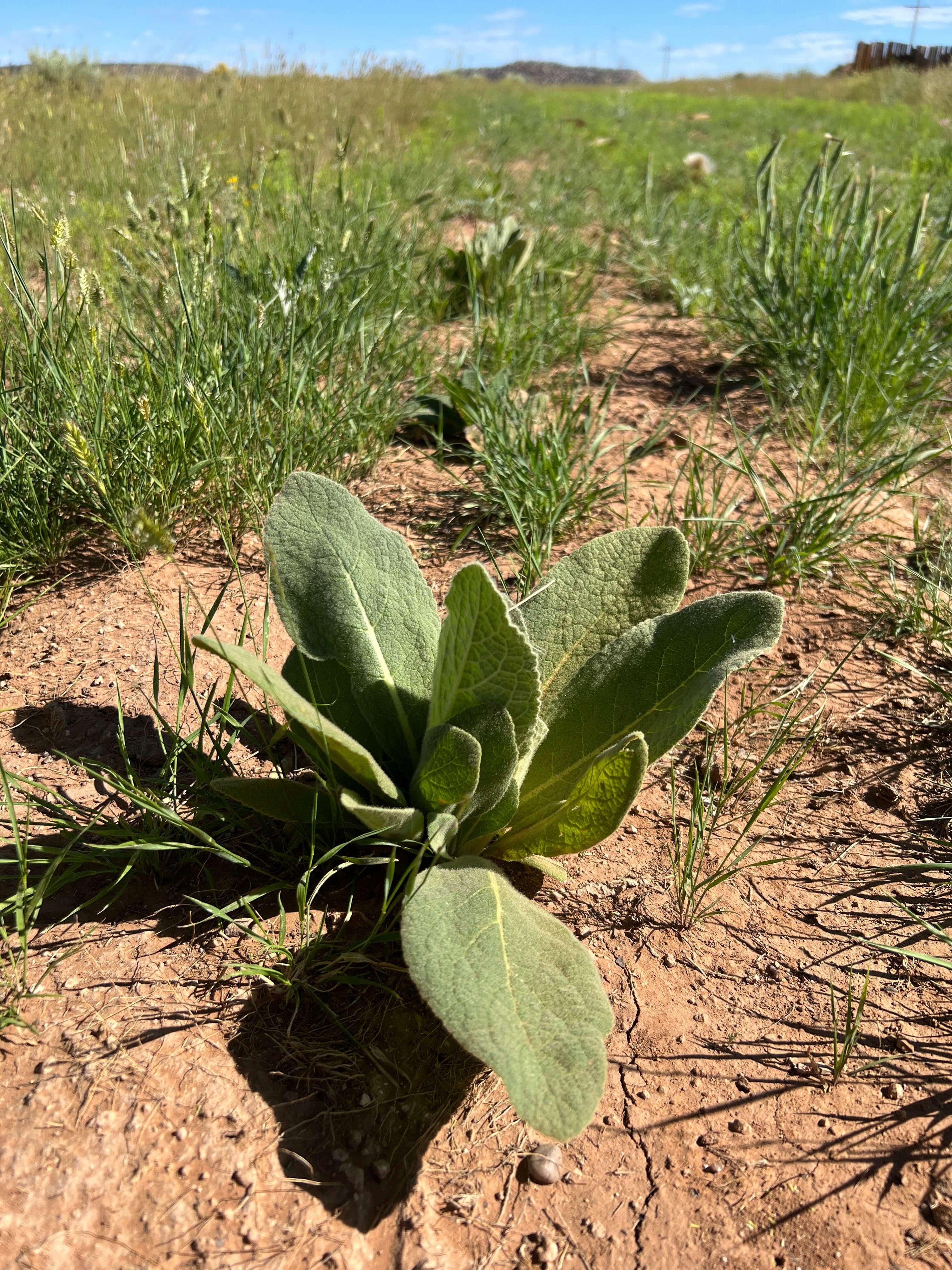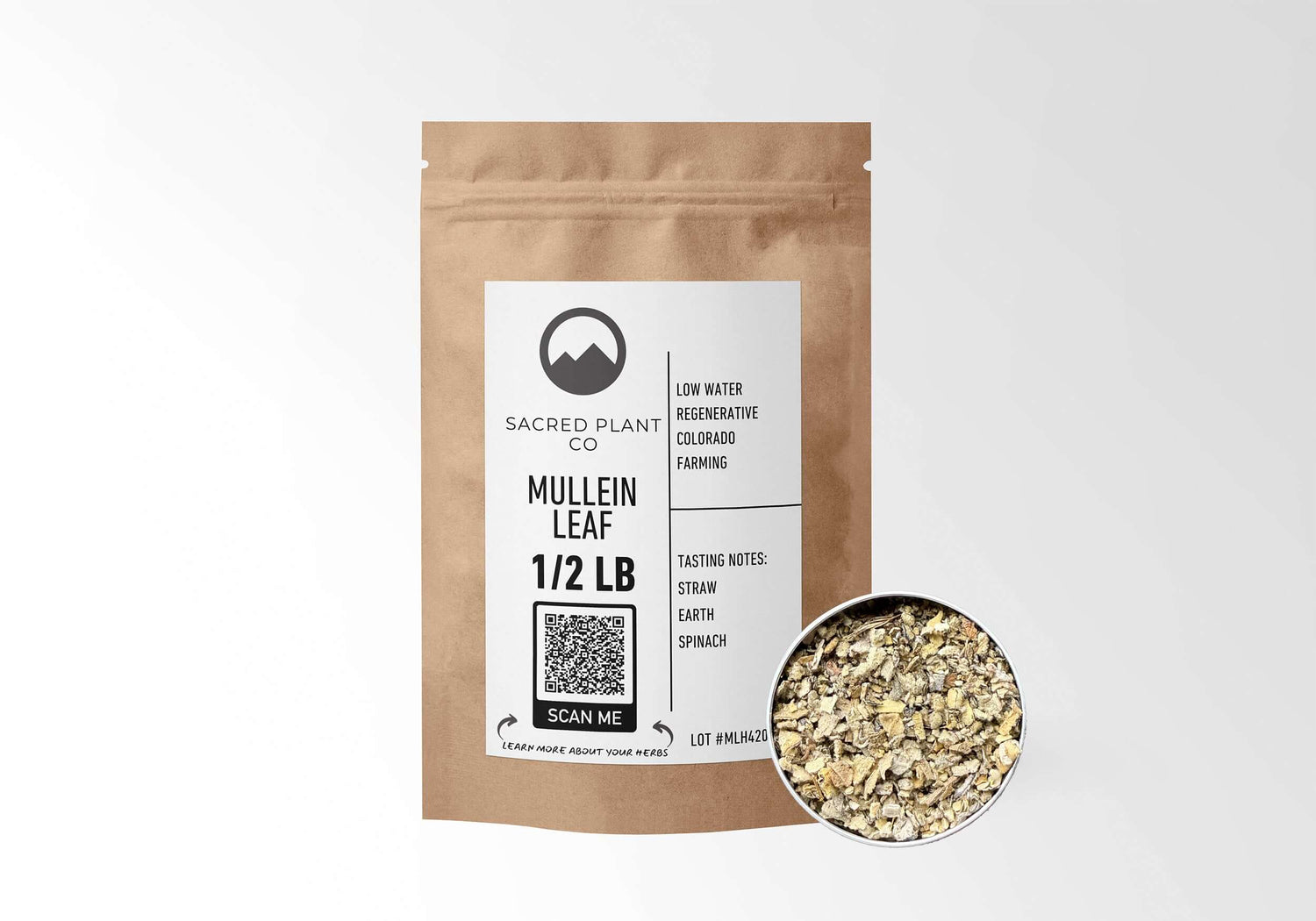Mullein Leaf: A Traditional Powerhouse
Our botanical odyssey through time and tradition takes us today to Mullein's soft, velvety leaves – a plant as fascinating as its distinctive appearance suggests.
Native American Reverence for Mullein
Native American tribes considered Mullein a potent plant ally, profoundly integrating it into their medicinal and spiritual practices. The leaves of Mullein, with their soothing and mucilaginous properties, were a cornerstone in traditional remedies to support respiratory health. These tribes, with their profound understanding of nature's pharmacy, harnessed the plant's potential in various forms to address a multitude of ailments.
Medicinal Uses
One of the primary uses of Mullein among Native American tribes was to alleviate respiratory issues. The leaves were often brewed into teas or made into poultices to treat coughs, bronchitis, and other lung-related conditions. The mucilaginous nature of Mullein leaves helped to soothe irritated mucous membranes, making it an effective remedy for persistent coughs and bronchial infections. Mullein tea provided relief and facilitated healing by creating a protective film over inflamed tissues.
In addition to teas, Native healers crafted poultices from Mullein leaves to apply directly to the chest. This method helped to draw out congestion, reduce inflammation, and ease breathing difficulties. The warmth and moisture from the poultice further enhanced the herb's therapeutic effects, offering comfort to those suffering from respiratory distress.

Smoking Blends
Another notable use of Mullein leaves was in smoking blends. Native American healers often included dried Mullein leaves in these blends to clear the lungs and soothe irritation. Unlike tobacco, Mullein's smoke was mild and less irritating, making it a preferred option for medicinal smoking. The practice was particularly beneficial for conditions like asthma and chronic bronchitis, where the inhalation of Mullein smoke helped to relax the respiratory tract and promote easier breathing.
Spiritual Significance
Beyond physical wellness, Mullein held significant spiritual value in Native American culture. The plant was believed to possess protective qualities, capable of warding off evil spirits and safeguarding individuals. Mullein leaves were sometimes carried as amulets or placed around living spaces to create a barrier against negative energies. The spiritual reverence for Mullein extended to its use in various ceremonies and rituals.
In spiritual practices, Mullein was often burned as incense to purify spaces and invite positive energies. The smoke was thought to carry prayers and intentions to the spirit world, acting as a conduit between the physical and spiritual realms. During healing ceremonies, Mullein was used to invoke the plant's protective and restorative powers, ensuring the well-being of the participants.
Integration into Daily Life
The integration of Mullein into daily life among Native American tribes highlights the plant's versatility and importance. It was a remedy for physical ailments and a spiritual ally that provided protection and facilitated connections with the divine. This multifaceted use of Mullein underscores the holistic approach to health and wellness practiced by Native American cultures, where the physical, mental, and spiritual aspects of life are deeply interconnected.
Mullein in European Tradition

Across the Atlantic, Mullein was fondly called the 'Candlewick Plant' in the old world of European tradition due to its practical uses and symbolic significance. The tall, sturdy stalks of Mullein were often dipped in grease or wax and then set alight to serve as torches during processions and rituals. This use of Mullein torches symbolized clarity and guidance, illuminating the way for participants in religious and secular ceremonies. The image of Mullein lighting the path speaks to its historical role in providing both physical light and metaphorical insight.
Practical Uses
The practical applications of Mullein extended beyond its use as torches. The plant's soft, downy leaves were ideal for making wicks for oil lamps, providing a slow-burning and efficient light source. This utility contributed to Mullein's reputation and widespread cultivation across Europe.
Herbal Medicine
Regarding wellness, Mullein was highly valued in European herbal medicine for its ability to support respiratory and skin health. Herbalists prepared Mullein leaf infusions, teas, and poultices to address a variety of ailments.
- Respiratory Health: Mullein's soothing and mucilaginous properties made it a popular remedy for respiratory issues. Herbalists brewed infusions and teas from the leaves to treat coughs, bronchitis, and throat irritations. The anti-inflammatory effects helped reduce inflammation in the airways, while the mucilage provided a protective coating to ease discomfort and facilitate healing. Mullein was also used in steam inhalations to clear nasal congestion and soothe irritated lungs.
- Skin Health: Mullein leaves were also applied externally to treat wounds, sores, and skin infections. The plant's anti-inflammatory and antimicrobial properties effectively reduced inflammation, prevented infection, and promoted the healing of damaged skin. Poultices made from the leaves were commonly used to draw out infections and soothe irritated or inflamed skin conditions, such as eczema and minor burns.
Symbolic and Cultural Significance
The symbolic use of Mullein in rituals extended to its cultural significance in various folklore and traditions. In some regions, Mullein was believed to possess protective qualities, similar to its role in Native American traditions. Bundles of Mullein were sometimes hung over doorways to ward off evil spirits or placed in fields to protect crops from pests.
Mullein also played a role in traditional European witchcraft and folk magic. Known as "Hag's Taper," it was thought to be a powerful plant for protection and banishing negative energies. The dried leaves and flowers were often included in spells and amulets designed to safeguard the home and its inhabitants.
Integration into Daily Life
The integration of Mullein into daily life in Europe highlights the plant's versatility and importance. Whether used for its practical applications in lighting, its medicinal benefits for respiratory and skin health, or its symbolic significance in rituals and folklore, Mullein was a cherished and widely utilized herb. The plant's enduring legacy in European tradition reflects its multifaceted role in providing light, healing, and protection.
Today, Mullein is appreciated for its historical significance and ongoing relevance in herbal medicine. Its applications in modern wellness practices honor the rich traditions and wisdom of European herbalists who recognized and celebrated the many virtues of this remarkable plant.
Ayurvedic and Traditional Chinese Medicine Perspectives
Ayurvedic Practices
In Ayurvedic medicine, Mullein is highly esteemed for its potential to balance the Kapha and Vata doshas. The Ayurvedic tradition emphasizes harmony within the body, mind, and spirit, and Mullein's warming and soothing qualities make it a valuable herb in this holistic approach.
Balancing Kapha and Vata Doshas.
- Kapha Dosha: Characterized by qualities such as heaviness, coolness, and dampness, an excess of Kapha can lead to congestion, mucus build-up, and sluggishness. Mullein's warming nature helps to balance Kapha by promoting warmth and dryness, clearing excess mucus and relieving respiratory congestion.
- Vata Dosha: Associated with dryness, cold, and movement, an imbalanced Vata can result in dry respiratory conditions, joint pain, and anxiety. Mullein's soothing properties counteract Vata's dryness, providing moisture and relief from respiratory and joint discomfort.
- Promoting Respiratory Health: Ayurvedic healers often employed Mullein in various preparations, such as teas, tinctures, and oils, to support respiratory health. The herb's demulcent properties help to soothe irritated mucous membranes, effectively treating conditions like coughs, bronchitis, and asthma. Its ability to clear excess mucus and alleviate congestion further enhances its respiratory benefits.
- Joint Health: Mullein is also used in Ayurvedic medicine to address joint pain and inflammation. Its warming quality helps to improve circulation and reduce inflammation in the joints. Ayurvedic practitioners might recommend Mullein-infused oils for massage to relieve arthritis pain and stiffness, leveraging its anti-inflammatory and analgesic effects.
Traditional Chinese Medicine (TCM)
In Traditional Chinese Medicine, Mullein is appreciated for its ability to nourish Yin energy, representing tranquility, moisture, and introspection. The balance of Yin and Yang is crucial in TCM, and Mullein plays a significant role in maintaining this equilibrium.
Nourishing Yin Energy:
- Yin Energy: Symbolizing qualities such as coolness, moisture, and stillness, Yin energy is essential for maintaining internal balance and health. Mullein's ability to moisten and soothe aligns perfectly with the needs of nourishing Yin, helping to counteract dryness and promote overall well-being.
- Respiratory Health: TCM practitioners use Mullein to support respiratory health by moistening the lungs and easing coughs. Its demulcent and expectorant properties make it effective in treating dry, persistent coughs and soothing irritated respiratory passages.Mullein is often included in herbal formulas aimed at addressing lung dryness and promoting healthy lung function.
- Mental and Emotional Benefits: Beyond its physical health benefits, Mullein is also valued in TCM for its calming effects on the mind. The herb is believed to help reduce stress and anxiety, promoting a sense of inner peace and emotional balance. By nourishing Yin energy, Mullein contributes to mental tranquility and introspection, making it a useful herb for managing stress-related conditions.
Integrating Mullein into Holistic Practices
The use of Mullein in both Ayurvedic and Traditional Chinese Medicine underscores its versatility and importance in holistic health practices. Its ability to balance doshas, nourish Yin energy, and provide relief for respiratory and joint issues highlights its multifaceted benefits. Modern herbalists continue to draw from these ancient traditions, incorporating Mullein into wellness routines to harness its therapeutic properties.
Whether used in teas, tinctures, oils, or topical applications, Mullein remains a valuable herb for promoting physical, mental, and emotional health. Its rich history in Ayurveda and TCM reflects a deep understanding of the plant's potential, bridging ancient wisdom with contemporary health practices. As we continue to explore and appreciate Mullein's benefits, we honor the enduring legacy of these traditional healing systems.
Feeling inspired to explore the traditions of Mullein? Here's a soothing recipe for you to try:
Mullein Soothing Herbal Tea
- 1 tablespoon of dried Mullein leaves
- 1 teaspoon of dried Chamomile flowers
- 1 teaspoon of dried Lavender flowers
- 2 cups of boiling water
- Honey or agave nectar to taste
Combine the Mullein leaves, chamomile, and lavender in a teapot or mason jar. Pour over the boiling water and let it steep for about 10-15 minutes. Strain and add honey or agave nectar to taste. Sip this calming brew before bed or when you need a moment of tranquility.
Ready to walk the path of tradition with Mullein? Discover its soft allure here.
Stay with us on this fascinating exploration through the garden of herbal wisdom with Sacred Plant Co. Until our next leaf turns, remain curious, remain green, and steeped in wellness.
Mullein Leaf FAQ
What is mullein leaf and how is it traditionally used?
How do I make a simple mullein tea?
What does mullein tea taste like?
How much should I use and how often?
Is mullein safe? Are there any side effects?
Who should avoid mullein or consult a professional first?
Can mullein be used in steams or blends?
What’s the difference between mullein leaf and flower?
How do I store mullein and how long does it keep?
How can I tell if my mullein is high quality?
Can mullein be combined with other herbs?
Is this medical advice?






